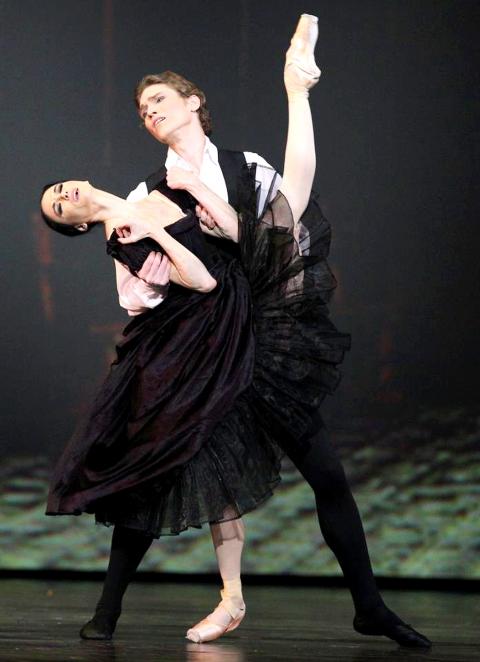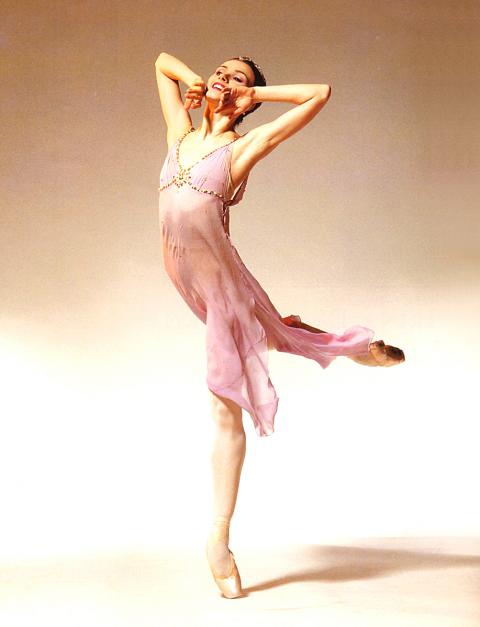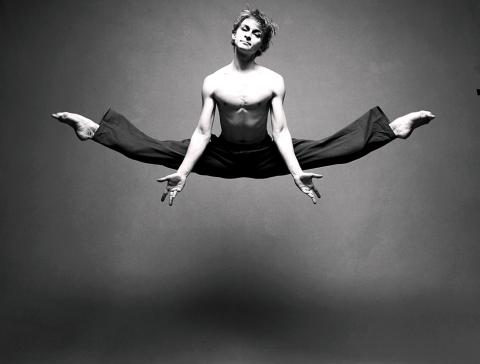Ballet lovers have a lot to be excited about in the coming weeks as the first half of the new year will see the National Theater and Experimental Theater packed with great dancers and companies. First up on the calendar is the 7th International Ballet Star Gala (第七屆 國際芭蕾舞星在台北) tomorrow night and Sunday afternoon.
It has been two long years since the sixth gala because teacher/impresario Wang Tzer-shing (王澤馨) and her husband, Chat Tzongue (謝宗益), who produce the shows under the auspices of their company Art Wave, were kept very busy arranging for the visits of the Universal Ballet and American Ballet Theater in 2012 and the Staatsballett Berlin last year, along with staging their third gala in Singapore.
However, judging from the lineup, the wait will prove to have been worth it. Wang has invited 12 dancers from eight companies for this weekend’s shows, mixing some new faces in with familiar favorites, as well as balancing the program between flamboyant classical duets that are gala standards — such as the Tchaikovsky, Le Corsair and Don Quixote pas de deux — and dances by some of the best choreographers working in ballet today.

Photo courtesy of Art Wave
This year’s cast is a mini-UN, with the dancers hailing from Russia, Ukraine, Spain, Albania, Georgia, Germany and Japan, a reflection of the change in the ballet world since the lift of the Iron Curtain made it possible for dancers — and choreographers — from Russia and Eastern Europe to travel and work abroad.
The National Theater is by now familiar territory for the Mariinsky Theatre’s Igor Kolb; he danced in the 2011 and 2012 galas and took part in the Mariinsky’s visits in 2004 and 2006.
Also making his fifth trip to Taipei is American Ballet Theater (ABT) principal Daniil Simkin, who has developed a major fanbase here since his first gala appearance in 2008. He partnered San Francisco Ballet’s Maria Kochetkova in the last gala and will do so again this weekend.

Photo courtesy of Roy Round/Art Wave
The Stuttgart Ballet is represented by principals Alicia Amatriain, who was in the 2012 gala, and Friedemann Vogel, who danced in the 2009 and 2010 shows.
Maia Makhateli from the Dutch National Ballet is also making a return visit; she was here in 2011.
Among the newcomers are two couples, former ABT principals Irina Dvorovenko and her husband, Maxim Beloserkovsky, and Lucia Lacarra and Marlon Dino from the Bayerisches Staatsballett.

Photo courtesy of Daniel Jackson / Art Wave
Rounding out the cast are Joaquin de Luz from the New York City Ballet (NYCB) and Misa Kuranaga from the Boston Ballet. Kuranaga is a last minute replacement for NYCB’s Ana Sophia Scheller, who was injured on Monday.
“It was crazy. I was up for 24 hours. We were so lucky to find a replacement and get her on a plane,” Wang said in an e-mail late last night.
Among the works on the program are four solos: Kolb will dance Vladimir Varnava’s Beginning, Kochetkova is dancing a yet-unnamed piece, Makhateli will dance Aurora’s Act I variation from Sleeping Beauty and Simkin will reprise Ben Van Cauwenbergh’s crowd-pleasing Le Bourgeois.
Along with the three classical pas de deux named above, Kolb will partner Makhateli in one from Marius Petipa’s Talisman and Lacarra and Dino are doing one from John Neumeier’s Lady of the Camillas.
The modern pas de deux include Anatoliy Beliy’s Cardio and Jessica Lang’s 2007 piece Splendid Isolation III, both of which will be danced by Dvorovenko and Beloserkovsky; and Ben Stevenson’s 3 Preludes, danced by Lacarra and Dino.
Unusually, two of the modern works are repeats from the 2012 show — Itzik Galili’s 2003 Mona Lisa and Rolando d’Alesio’s Come Neve al Sole — but they were the highlights of that program, and this reviewer cannot wait to see them again. Amatriain was amazing in both. In 2012 she was partnered by Stuttgart colleague Jason Reilly; this time she will dance with Vogel.
Wang tries very hard not to play favorites, either with the dancers or the works, but she said she was really looking forward to seeing Kolb in Beginning, which was inspired by Rene Magritte’s 1964 painting Le Fils de l’Homme (The Son of Man), as well as Dvorovenko and Beloserkovsky in the 10-minute-long Splendid Isolation III.
The International Ballet Star Gala always sets a high bar for other productions planned for Taipei and audiences will not have to wait long to draw comparisons. The St. Petersburg Ballet Theatre is bringing its Swan Lake and The Nutcracker to the National Theater next week, followed by the Kaohsiung City Ballet’s (高雄城市芭蕾舞團) 2014 Dance Shoe on Jan. 18 and Jan. 19, Jiri Kylian’s Kylworks from Feb. 21 to Feb. 23 and French ballerina Sylvie Guillem’s 6,000 Miles Away on April 12 and April 13.
This is shaping up to be a good year for Taiwan’s ballet fans.
This story has been updated since it was first published.

In the March 9 edition of the Taipei Times a piece by Ninon Godefroy ran with the headine “The quiet, gentle rhythm of Taiwan.” It started with the line “Taiwan is a small, humble place. There is no Eiffel Tower, no pyramids — no singular attraction that draws the world’s attention.” I laughed out loud at that. This was out of no disrespect for the author or the piece, which made some interesting analogies and good points about how both Din Tai Fung’s and Taiwan Semiconductor Manufacturing Co’s (TSMC, 台積電) meticulous attention to detail and quality are not quite up to

April 21 to April 27 Hsieh Er’s (謝娥) political fortunes were rising fast after she got out of jail and joined the Chinese Nationalist Party (KMT) in December 1945. Not only did she hold key positions in various committees, she was elected the only woman on the Taipei City Council and headed to Nanjing in 1946 as the sole Taiwanese female representative to the National Constituent Assembly. With the support of first lady Soong May-ling (宋美齡), she started the Taipei Women’s Association and Taiwan Provincial Women’s Association, where she

Chinese Nationalist Party (KMT) Chairman Eric Chu (朱立倫) hatched a bold plan to charge forward and seize the initiative when he held a protest in front of the Taipei City Prosecutors’ Office. Though risky, because illegal, its success would help tackle at least six problems facing both himself and the KMT. What he did not see coming was Taipei Mayor Chiang Wan-an (將萬安) tripping him up out of the gate. In spite of Chu being the most consequential and successful KMT chairman since the early 2010s — arguably saving the party from financial ruin and restoring its electoral viability —

It is one of the more remarkable facts of Taiwan history that it was never occupied or claimed by any of the numerous kingdoms of southern China — Han or otherwise — that lay just across the water from it. None of their brilliant ministers ever discovered that Taiwan was a “core interest” of the state whose annexation was “inevitable.” As Paul Kua notes in an excellent monograph laying out how the Portuguese gave Taiwan the name “Formosa,” the first Europeans to express an interest in occupying Taiwan were the Spanish. Tonio Andrade in his seminal work, How Taiwan Became Chinese,